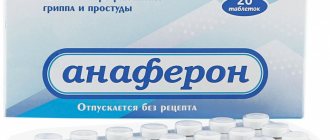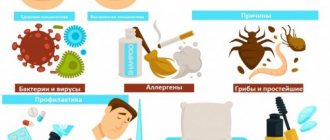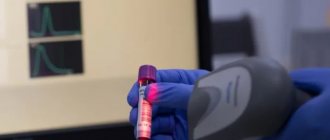Composition and release form
The drug is dispensed in the form of tablets and medicinal solution for oral administration.
Ergoferon tablets are white, cylindrical in shape with a groove in the middle. Packed in cardboard packaging with 2 blisters, each containing 10 pieces.
The solution is a clear liquid with a volume of 100 ml. Contained in a bottle with attached instructions for use.
The active components of the drug are specific antibodies to histamine, CD4 and human interferon gamma. Excipients: lactose, cellulose, magnesium stearate in tablet form. Also citric acid, distilled water, potassium sorbate, glycerol and maltitol in solution.
Analogs
There are no complete analogues of Ergoferon for children on sale; there are only medications that have a similar therapeutic effect:
- Agri for children. Russian homeopathic remedy, which is available in lingual tablets and granules, approved for patients over 3 with ARVI. This is a cheap analogue of Ergoferon for children, the cost of the drug is about 50 rubles.
- Oscillococcinum. French homeopathic remedy that is used for acute respiratory viral infections and influenza. For kids, first dilute it in water. The price of the drug varies from 380 to 1340 rubles.
Doctors often prescribe Anaferon, Kagocel, Arbidol and Tsitovir for colds.
pharmachologic effect
The therapeutic properties of the drug are characterized by stopping the activity of pathogens, reducing inflammation, pain and strengthening the immune status.
After taking Ergoferon the following is noted:
- Suppressing signs of intoxication - reducing swelling, temperature, runny nose and cough.
- Improving the structure of blood vessels.
- Increasing the body's resistance to viral pathologies.
- Decreased bronchial tone.
The active ingredients of the drug have a pharmacological effect at the cellular level, helping to activate metabolism and strengthen the immune system, which leads to rapid recovery.
The child has a sore throat - please advise something.
In addition to the drug for a sore throat, I recommend that you take an antiviral drug - Ergoferon or Anaferon for children. What age is the baby? For a child over 6 months old, I can recommend Ergoferon, which has additional effects and helps relieve ARVI symptoms such as sore throat, runny nose and nasal congestion. And for babies from 1 month there is “Anaferon for children” in a convenient drop form.
THERE ARE CONTRAINDICATIONS.
BEFORE USE, CONSULT A PROFESSIONAL.
Indications for use of Ergoferon
The antiviral agent has a wide range of pharmacological effects. Prescribed for the treatment of the following conditions:
- Whooping cough.
- Influenza, parainfluenza, caused by A and B viruses.
- Fever with hemorrhagic course.
- Pneumonia of any form and etiology, including atypical.
- Inflammatory lesions of the brain (meningitis, encephalitis).
- Tonsillitis, bronchitis.
- Chicken pox.
In addition, Ergoferon is used as part of the complex treatment of intestinal infections against the background of rotoviruses, enteroviruses, adenoviruses and other pathogens. It is also widely used for the prevention of influenza and ARVI.
Ergoferon tablet d/rassas pack cont cell/pack card x20
ERGOFERON Registration number LSR-007362/10-290710 Trade name Ergoferon Dosage form lozenges Composition (per 1 tablet) Active substances: antibodies to human interferon gamma, affinity purified - 0.006 g* antibodies to histamine, affinity purified - 0.006 g* antibodies to CD4 affinity purified - 0.006 g* Excipients: lactose monohydrate, microcrystalline cellulose, magnesium stearate. Flat-cylindrical tablets with a score and a bevel, from white to almost white. On the flat side with a mark there is the inscription MATERIA MEDICA, on the other flat side there is the inscription ERGOFERON. Pharmacotherapeutic group Antiviral agent, antihistamine Codes ATX JOSAX, R06A Pharmacological properties Pharmacodynamics The spectrum of pharmacological activity of ergoferon includes antiviral, immunomodulatory, antihistamine, anti-inflammatory. The effectiveness of the use of ergoferon components in viral infectious diseases has been experimentally and clinically proven: influenza A (seasonal influenza, avian influenza A/H5N1 and swine influenza A/H1N1) and influenza B, acute acute respiratory viral infections (caused by parainfluenza viruses, adenoviruses , respiratory syncytial viruses, coronaviruses), herpes viral infections (labial herpes, ophthalmic herpes, genital herpes, herpes zoster, chicken pox, infectious mononucleosis), acute intestinal infections of viral etiology (caused by caliciviruses, coronaviruses, rotaviruses, enteroviruses), enteroviral and meningococcal meningitis s , hemorrhagic fever with renal syndrome, tick-borne encephalitis. The drug is used in the complex treatment of bacterial infections (pseudotuberculosis, whooping cough, yersiniosis, pneumonia of various etiologies, including atypical pathogens (M. pneumoniae, C. Pneumoniae, Legionella spp.), is used to prevent bacterial complications of viral infections, prevents the development of superinfections. Use of the drug in pre- and post-vaccination period increases the effectiveness of vaccination, provides non-specific prevention of ARVI and influenza at the time of formation of post-vaccination immunity. Ergoferon has preventive effectiveness against ARVI of non-influenza etiology, prevents the development of intercurrent diseases in the post-vaccination period. The components included in the drug have a single mechanism of action in in the form of an increase in the functional activity of the CD4 receptor, receptors for interferon gamma (IFN-γ) and histamine, respectively, which is accompanied by a pronounced immunotropic effect. It has been experimentally proven that antibodies to interferon gamma: increase the expression of IFN-γ, IFI a/B, as well as related with them interleukins (IL-2, IL-4, IL-10, etc.), improve the ligand-receptor interaction of IFN, restore cytokine status, normalize the concentration and functional activity of natural antibodies to IFN-γ, which are an important factor in the body’s natural antiviral tolerance , stimulate interferon-dependent biological processes: induction of expression of major histocompatibility complex antigens of types I, II and Fc receptors, activation of monocytes, stimulation of the functional activity of NK cells, regulation of immunoglobulin synthesis, activating mixed THI and THI regulation of immunoglobulin synthesis, activating mixed Th1 and Th2 immune answer. Antibodies to CD4, probably being allosteric modulators of this receptor, regulate the functional activity of the CD4 receptor, which leads to an increase in the functional activity of CD4 lymphocytes, normalization of the CD4/CD8 immunoregulatory index, as well as the subpopulation composition of immunocompetent cells (CD3, CD4, CDS, CD 16, CD20) . Antibodies to histamine modify histamine-dependent activation of peripheral and central H1 receptors and thus reduce the tone of bronchial smooth muscles, reduce capillary permeability, which leads to a reduction in the duration and severity of rhinorrhea, swelling of the nasal mucosa, coughing and sneezing, as well as a decrease in the severity of associated the infectious process of allergic reactions by suppressing the release of histamine from mast cells and basophils, the production of leukotrienes, the synthesis of adhesion molecules, reducing the chemotaxis of eosinophils and platelet aggregation in reactions to contact with an allergen. The combined use of the components of a complex drug is accompanied by an increase in the antiviral activity of its components. Pharmacokinetics The sensitivity of modern physicochemical methods of analysis (gas-liquid chromatography, high-performance liquid chromatography, gas chromatography-mass spectrometry) does not allow assessing the content of ultra-low doses of antibodies in biological fluids, organs and tissues, which makes it technically impossible to study the pharmacokinetics of the drug Ergoferon. Indications for use Prevention and treatment of influenza A and B (including bird flu A/H5N1 and swine flu A/H1N1). Prevention and treatment of acute respiratory viral infections caused by parainfluenza virus, adenovirus, respiratory syncytial virus, coronavirus. Prevention and treatment of herpes virus infections (labial herpes,
ophthalmoherpes, genital herpes, chicken pox, herpes zoster,
Infectious mononucleosis).
Prevention and treatment of acute intestinal infections of viral etiology (caused by calicivirus, adenovirus, coronavirus, rotavirus, enteroviruses). Prevention and treatment of enteroviral and meningococcal meningitis, hemorrhagic fever with renal syndrome, tick-borne encephalitis. Use in complex therapy of bacterial infections (pseudotuberculosis, whooping cough, yersiniosis, pneumonia of various etiologies, including those caused by atypical pathogens (M. pneumoniae, S. pneumoniae, Legionella spp)), prevention of bacterial complications of viral infections, prevention of superinfections. Contraindications Increased individual sensitivity to the components of the drug Pregnancy and lactation The safety of Ergoferon during pregnancy and lactation has not been studied. If it is necessary to prescribe a drug, the risk/benefit ratio should be taken into account. Directions for use and dosage: Inside. For one dose - 1 tablet (not during meals). The tablet should be kept in the mouth without swallowing until completely dissolved. Children from 6 months. When prescribing the drug to young children (from 6 months to 3 years), it is recommended to dissolve the tablet in a small amount (1 tablespoon) of boiled water at room temperature. Treatment should be started as early as possible, when the first signs of acute infection appear, according to the following scheme: in the first 2 hours the drug is taken every 30 minutes, then during the first 24 hours three more doses are taken at regular intervals. From the second day onwards, take 1 tablet 3 times a day until complete recovery. For the prevention of viral infectious diseases - 1-2 tablets per day. The recommended duration of the preventive course is determined individually and can be 1-6 months.
If necessary, the drug can be combined with other antiviral and symptomatic drugs. Side effects. Individual hypersensitivity reactions to the components of the drug are possible. Overdose In case of accidental overdose, dyspepsia may occur due to the excipients included in the drug. Interaction with other medicinal products No cases of incompatibility with other medicinal products have been reported to date. Special instructions The drug contains lactose, and therefore it is not recommended for use in patients with congenital galactosemia, glucose or galactose malabsorption syndrome, or congenital lactase deficiency. Ergoferon does not affect the ability to drive vehicles and other potentially dangerous mechanisms. Release form Lozenges. 20 tablets each in a blister pack made of polyvinyl chloride film and aluminum foil. 1, 2 or 5 blister packs together with instructions for medical use are placed in a cardboard pack. Storage conditions In a place protected from light, at a temperature not exceeding 25 0C. Keep out of the reach of children. Shelf life: 3 years Do not use after expiration date. Conditions for dispensing from pharmacies Without a prescription
How to take Ergoferon for adults
It is allowed to take 1 tablet or 5 ml of solution at a time. It is forbidden to swallow the drug immediately; the tablet is kept in the mouth until completely dissolved, the solution is swallowed after 30-60 seconds.
The regimen is as follows:
- The first 2 hours - take 5 medicinal doses at intervals of 30 minutes.
- The first day - drink the product at equal intervals 3 times.
- From 2 to 5 days - take the permissible dose of the drug every 8 hours.
Contraindications
Tablets should not be given if:
- individual susceptibility and allergies to constituent components;
- up to 6 months of age.
The solution is contraindicated in the following cases:
- fructose intolerance;
- individual hypersensitivity or allergy to the constituent components;
- age up to 3 years.
People with diabetes should take the drug with caution, as it contains sugar.
The drug does not affect the ability to drive a vehicle or operate various mechanisms.
To date, there have been no cases of incompatibility when taken simultaneously with other medications.





